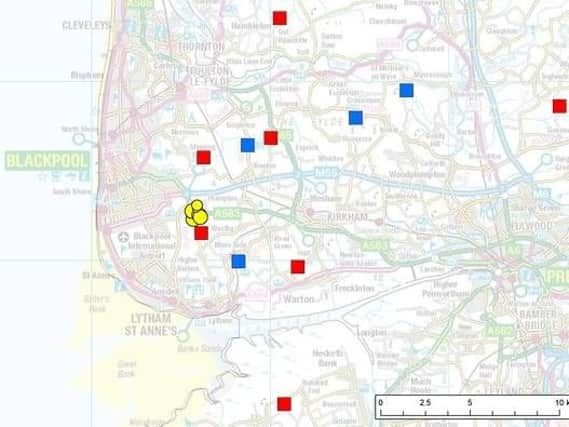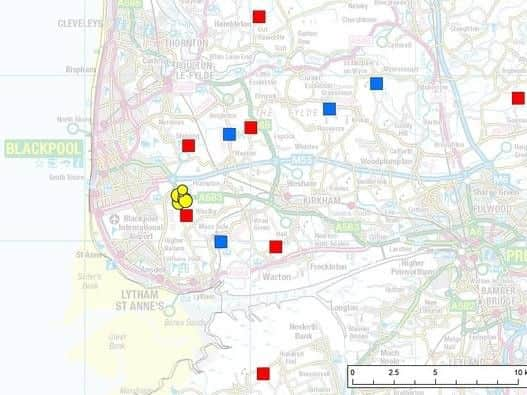Fracking in Lancashire: Your questions answered about the seismic activity at the Preston New Road site


Are the earthquakes related to hydraulic fracturing?
Hydraulic fracturing operations started at Preston New Road, near Blackpool, on 15 October. The first event BGS detected in the area was on 18 October. This is not unexpected since hydraulic fracturing is generally accompanied by microseismicity (very small earthquakes that are too small to be felt).
How big are the events?


The largest event that we have detected to date had magnitudes of 1.1 ML. Earthquakes with magnitude less than 2 are not usually felt and if they are felt then by only a few people very close to the earthquake. Earthquakes with magnitudes less than 1 are hardly ever felt. The smallest earthquake felt in the UK had a magnitude of 0.5 and was felt by one person.
Advertisement
Hide AdAdvertisement
Hide AdThe magnitude 0.8 ML event at 11:36 UTC on 26 October was around 200 times smaller than the magnitude 2.3 ML event that stopped hydraulic fracturing operations at Preese Hall in 2011. The maximum recorded ground motion was around 0.1 mm/s. This is well below the limits set for quarry operations (6 mm/s). The BGS network of sensors across the UK routinely detects many blasts from quarry operations around the UK with magnitudes of up to around 2 ML every day.
How often do earthquakes of this size occur?
Earthquakes have an exponential frequency-magnitude distribution, so for unit decrease in magnitude there are approximately ten times as many earthquakes. On average there are around 20-30 earthquakes with a magnitude of 2 ML or greater every year somewhere in the UK or immediate offshore area. That means we should expect several hundred earthquakes with a magnitude of 1.0 ML or above and several thousand with a magnitude of 0 ML or above. The number of earthquakes also roughly scales proportional to an area, so a small region of the UK will have fewer events.
Why are British Geological Survey able to detect such small earthquakes?
A dense network of temporary seismic sensors around Blackpool allows the BGS to detect much smaller earthquakes than we are typically able to do in other parts of the UK. The BGS permanent network of sensors across the UK is usually able to detect most earthquakes with magnitudes of 2.0 ML or above anywhere in the UK, though this may vary from place to place and also at different times. All of the events detected near Preston New Road have magnitudes that are far below our normal detection threshold.
How can earthquake magnitudes be negative?
Advertisement
Hide AdAdvertisement
Hide AdMagnitude scales are logarithmic. This means that the amplitude recorded must decrease 10 times for the magnitude to decrease by 1 unit.
At a station close to a magnitude 2 earthquake, the ground moves about 400 micrometres. So a ground movement of 40 micrometres would signify a magnitude 1 earthquake, 4 micrometres a magnitude 0 earthquake and 0.4 micrometres a magnitude -1 earthquake.
Earthquakes with negative magnitudes are never felt.
Why does hydraulic fracturing cause seismicity?
The injection of high pressure fluid into intact rock generates cracks. The cracks grow as a result of tiny seismic events at the tips. This process increases the permeability of the rock, allowing trapped hydrocarbons to be extracted. These events are often referred to as induced and the energy for them is limited by the amount of energy in the injection process. This means the magnitudes are generally small.
The injected fluid can also change pore fluid pressures and deformation in the rock mass. Increased fluid pressures can trigger slip on pre-existing faults by reducing the stress that stops the rocks on either side of the fault from sliding. These are often referred to as triggered events and the energy for them comes largely from previously accumulated strain energy. The earthquakes that occurred during hydraulic fracturing operations at Preese Hall, near Blackpool, in 2011 are thought to have been triggered events. The largest of these had a magnitude of 2.3 ML.
More information about earthquake magnitude and other activities that can cause tremors can be found on the original FAQ piece here